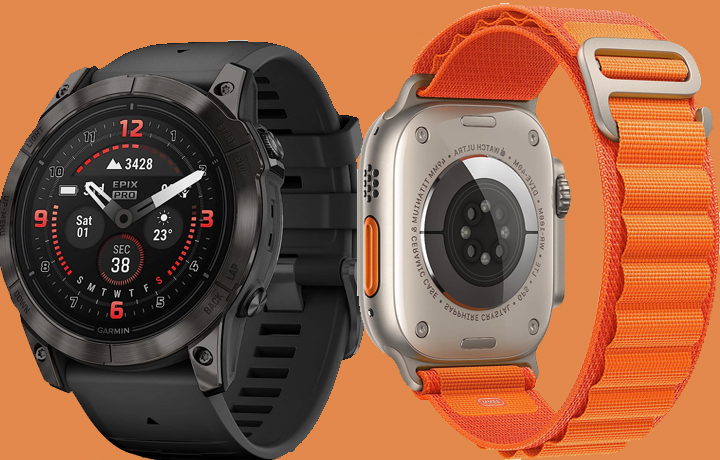In the rapidly evolving world of smartwatches, heart rate monitoring has become a cornerstone feature for fitness enthusiasts and casual users alike. Among the frontrunners in this technology race are Apple with their Apple Watch Ultra and Garmin with their new 5th generation Elevate heart rate sensor, featured on their Epix Pro and Fenix 7 Pro lines of watches.
While both companies offer advanced optical heart rate monitoring, they target different activities and levels of accuracy. In this comprehensive comparison review, we dive into the nitty-gritty of how these two sensors perform across a range of activities, highlighting their strengths and areas of improvement.
- Shop using our links and support us:
- Buy Apple Watch Ultra on Amazon>>
- Buy Garmin Finex Pro On Amazon>>
- Buy Garmin Epix Pro on Amazon>>
Understanding Optical Heart Rate Sensors
Optical heart rate sensors work by emitting light into the skin and measuring the reflections to calculate heart rate. While these sensors are adept at steady-state activities with minimal wrist movement, challenges arise when tracking activities with varying arm motion, grip pressure, and external vibrations. This review focuses on activities like running, cycling, mountain biking, weight training, and high-intensity interval training, which push these sensors to their limits.
Steady State Activities: A Strong Start
In controlled environments, both the Apple Watch Ultra and the Garmin’s 5th generation sensor proved their accuracy. Steady-state indoor cycling showcased the sensors’ ability to deliver reliable heart rate data, aligning closely with each other. These watches excelled in maintaining accuracy during road biking as well, indicating their prowess in handling vibrations and gripping-related variations.
Challenges with Running
Running introduces arm movement and fluctuating grip pressure, creating potential pitfalls for heart rate sensors. While both devices exhibited initial lock-on delays, their performance remained consistent during steady-state runs.
However, the Apple Watch Ultra experienced slight deviations during intense pace increases, reflecting the challenges it faces with re-establishing accurate tracking. When switched to different wrists, the Ultra demonstrated some inconsistencies in tracking, suggesting sensitivity to wrist-specific variations.
- Check out these also:
- Xiaomi Watch S1 Pro Review
- Huawei Watch Buds Review
Mountain Biking: A Test of Stability
Mountain biking posed a unique challenge due to erratic wrist movements and vibrations. Surprisingly, both the Apple Watch Ultra and Garmin’s sensor performed admirably well.
The Apple Watch Ultra struggled to regain tracking after losing connection, while the Garmin sensor displayed better resilience in such situations. However, both devices maintained a commendable level of accuracy overall, despite the tumultuous terrain.
Weight Training and High-Intensity Interval Training
Weight training and high-intensity interval training are notorious for their impact on heart rate sensor accuracy. Gripping weights and rapid arm movement can disrupt blood flow, affecting sensor performance.
Both devices showcased notable accuracy in weight training, with the Apple Watch Ultra slightly edging out the Garmin sensor. However, during high-intensity intervals, the Ultra consistently held a closer resemblance to external heart rate straps, indicating its advantage in capturing rapid fluctuations.
The Battle of Precision: Apple Watch Ultra vs Garmin’s 5th Generation Sensor
Summarizing the results of this thorough comparison, the Apple Watch Ultra and Garmin’s 5th generation sensor emerged as exceptional contenders in the heart rate monitoring arena. However, each had its own strengths and areas of excellence.
The Apple Watch Ultra excelled in activities like weight training and high-intensity interval training, providing accurate data even during rapid changes in heart rate. On the other hand, Garmin’s sensor showcased superior stability during mountain biking and demonstrated resilience in recovering lost connections.
Conclusions and Recommendations
In the quest for accurate heart rate monitoring, both the Apple Watch Ultra and Garmin’s 5th generation sensor proved their mettle across various activities. While neither device achieved absolute perfection, their capabilities are impressive. For those engaged in weight training and high-intensity interval training, the Apple Watch Ultra offers a slight edge. Meanwhile, mountain biking enthusiasts might find Garmin’s sensor more reliable due to its ability to recover from disruptions.
Ultimately, the choice between these two exceptional sensors boils down to personal preferences and the specific activities you engage in. For utmost precision, external heart rate straps remain the gold standard. However, the advancements showcased by both the Apple Watch Ultra and Garmin’s 5th generation sensor make them reliable companions for tracking your heart rate during a diverse range of activities. As technology continues to evolve, it’s an exciting time for fitness enthusiasts, as these smartwatches pave the way for more accurate and insightful health monitoring experiences.
- Shop using our links and support us:
- Buy Apple Watch Ultra on Amazon>>
- Buy Garmin Finex Pro On Amazon>>
- Buy Garmin Epix Pro on Amazon>>







